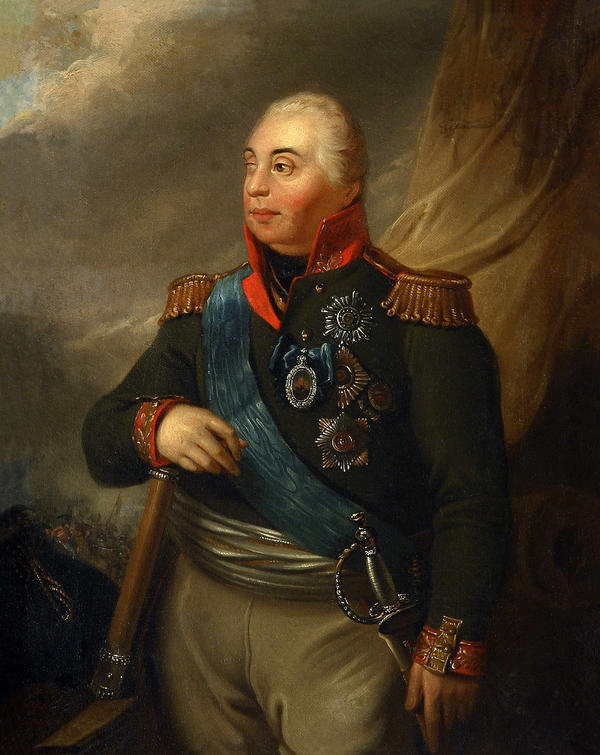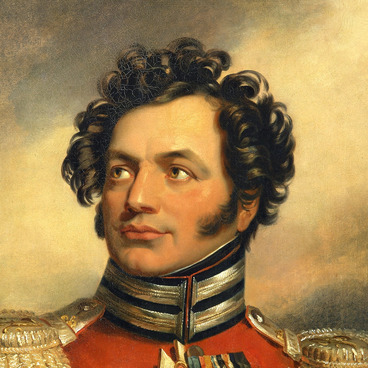Outstanding Russian commander, the lightest prince Smolensky, general field marshal Kutuzov was born in the family of a commissioned General. He studied at the Artillery and Engineering Noble School, where his father taught. Kutuzov graduated School with honors and stayed there as a teacher of mathematics.
In 1761 at the rank of engineer-foreman Kutuzov was sent to serve the Astrakhan infantry regiment. He took part in the war with the Polish Confederates.
During the Russo-Turkish War in 1774 near Alushta Kutuzov had a serious gunshot wound in a left temple and damaged his eye. According to researchers, this wound determined the commander`s glory and his non-standard ways of thinking. In 1788, during the siege of Ochakov, meeting the attack of the Turks, he was wounded in the head for the second time: the bullet punched the cheek and reached the back of the head.
In December 1790 Kutuzov participated in the assault of Ishmael. In 1792-1794 Mikhail Kutuzov headed the Russian military emergency embassy in Constantinople. In 1798 Mikhail Kutuzov was promoted from infantile to General. He was a Lithuanian and St. Petersburg military governor. He then fallen out of favoury and was forced to resign from the army. At the beginning of the Patriotic War of 1812 Mikhail Kutuzov was appointed the position of Commander-in-Chief. When he arrived in the army, he decided to give a general battle to Napoleon 's troops near Borodino.
During the Russo-Turkish War in 1774 near Alushta Kutuzov had a serious gunshot wound in a left temple and damaged his eye. According to researchers, this wound determined the commander`s glory and his non-standard ways of thinking. In 1788, during the siege of Ochakov, meeting the attack of the Turks, he was wounded in the head for the second time: the bullet punched the cheek and reached the back of the head.
In December 1790 Kutuzov participated in the assault of Ishmael. In 1792-1794 Mikhail Kutuzov headed the Russian military emergency embassy in Constantinople. In 1798 Mikhail Kutuzov was promoted from infantile to General. He was a Lithuanian and St. Petersburg military governor. He then fallen out of favoury and was forced to resign from the army. At the beginning of the Patriotic War of 1812 Mikhail Kutuzov was appointed the position of Commander-in-Chief. When he arrived in the army, he decided to give a general battle to Napoleon 's troops near Borodino.
Thanks to Kutuzov 's strategy, the Russian army won against a strong opponent. In December 1812 Kutuzov got the title of Prince of Smolensk and was awarded the supreme military Order of George of Ist degree.
The legendary commander was portrayed many times. His portraits were painted by both Russian and foreign artists.
In 1813 the artist Volkov painted a portrait of Kutuzov in the traditions of the 18th century. We can see the image of the perfect grandeur and wise warrior. The commander is depicted as an old man. With his right hand, he is resting on the spy pipe, and with his left hand, he is holding a sword. There are Andreev ribbon and orders on the chest: Andrei the First-Called, Georgy the Victorious, Vladimir the 2nd degree, Austrian Order Maria Teresia. Alexander I’s portrait, showered with diamonds is on the blue bow.
The background tells us about courage and devotion of the character: on the right at the top there’s a flag, with the image of a two-headed eagle, under it ― a gun barrel. In the background, on the bottom left, there’re rows of the attacking horse troops. According to contemporaries, Volkov 's portrait is the most successful image of Kutuzov. This portrait was used by the English painter Dow George when creating the parade portrait of Kutuzov for the Military Gallery of the Winter Palace.
In 1813 the artist Volkov painted a portrait of Kutuzov in the traditions of the 18th century. We can see the image of the perfect grandeur and wise warrior. The commander is depicted as an old man. With his right hand, he is resting on the spy pipe, and with his left hand, he is holding a sword. There are Andreev ribbon and orders on the chest: Andrei the First-Called, Georgy the Victorious, Vladimir the 2nd degree, Austrian Order Maria Teresia. Alexander I’s portrait, showered with diamonds is on the blue bow.
The background tells us about courage and devotion of the character: on the right at the top there’s a flag, with the image of a two-headed eagle, under it ― a gun barrel. In the background, on the bottom left, there’re rows of the attacking horse troops. According to contemporaries, Volkov 's portrait is the most successful image of Kutuzov. This portrait was used by the English painter Dow George when creating the parade portrait of Kutuzov for the Military Gallery of the Winter Palace.



